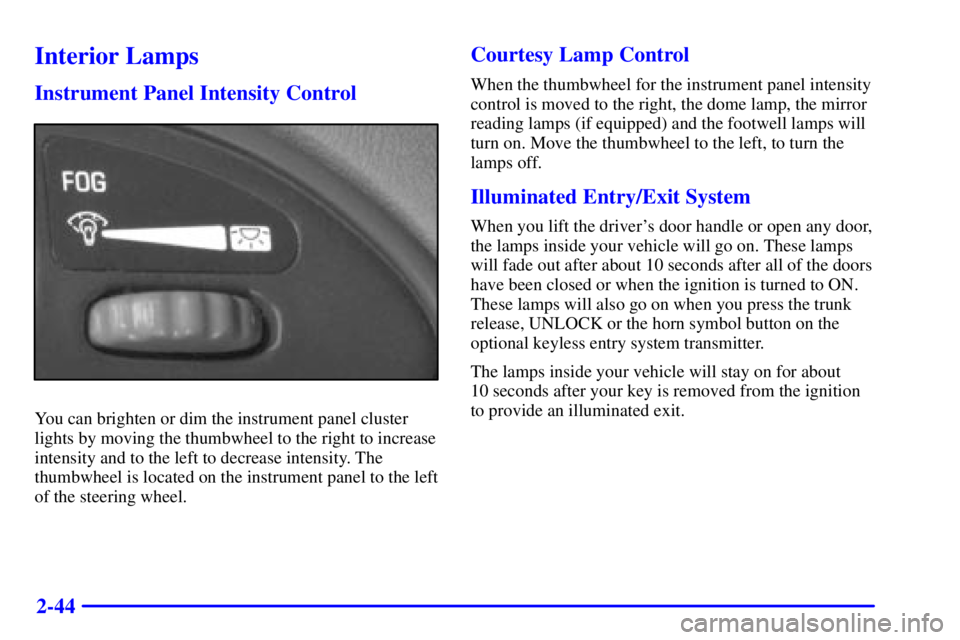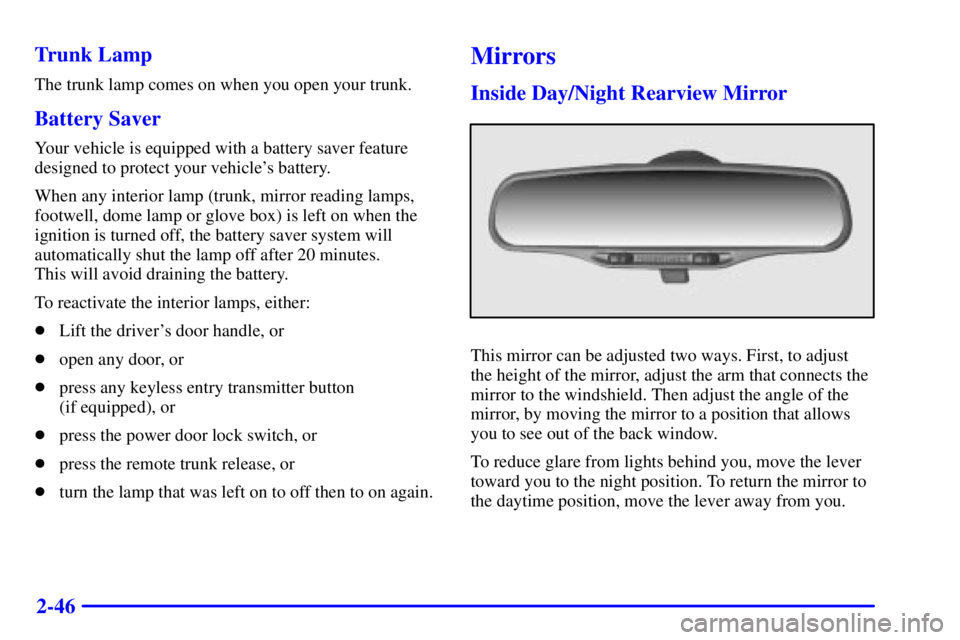Page 4 of 318
ii
Table of Contents
Keys and Door Locks
Remote Keyless Entry System
Trunk Release
Automatic Transmission (If Equipped)
Manual Transmission
Parking Brake
Windows
Tilt Wheel
Turn Signal/Multifunction LeverWindshield Wipers
Cruise Control
Interior and Exterior Lamps
Mirrors
Storage Compartments
Convenience Net (If Equipped)
Sunroof (If Equipped)
Instrument Panel, Warning Lights and Gages Seats and Seat Controls
Safety BeltsAir Bag Systems
Child Restraints
Section
1
Section
2
Seats and Restraint Systems
Features and Controls
Page 66 of 318

2-
2-1
Section 2 Features and Controls
Here you can learn about the many standard and optional features on your vehicle, and information on starting,
shifting and braking. Also explained are the instrument panel and the warning systems that tell you if everything is
working properly
-- and what to do if you have a problem.
2
-2 Keys
2
-4 Door Locks
2
-9 Keyless Entry System If Equipped)
2
-12 Trunk
2
-14 Theft
2
-15 Passlock�
2-16 New Vehicle ªBreak-Inº
2
-16 Ignition Switch
2
-17 Starting Your Engine
2
-20 Engine Coolant Heater (If Equipped)
2
-22 Automatic Transaxle Operation
2
-25 Manual Transaxle Operation
2
-27 Parking Brake
2
-28 Shifting Into PARK (P)
(Automatic Transaxle Only)
2
-30 Shifting Out of PARK (P)
(Automatic Transaxle Only)
2
-30 Parking Your Vehicle
(Manual Transaxle Models Only)2
-30 Parking Over Things That Burn
2
-31 Engine Exhaust
2
-32 Running Your Engine While You're Parked
(Automatic Transaxle)
2
-33 Windows
2
-34 Tilt Wheel
2
-34 Turn Signal/Multifunction Lever
2
-41 Exterior Lamps
2
-44 Interior Lamps
2
-46 Mirrors
2
-48 Storage Compartments
2
-48 Ashtray and Lighter (If Equipped)
2
-49 Sun Visors
2
-49 Sunroof (If Equipped)
2
-50 The Instrument Panel-Your
Information System
2
-54 Warning Lights, Gages and Indicators
Page 109 of 318

2-44
Interior Lamps
Instrument Panel Intensity Control
You can brighten or dim the instrument panel cluster
lights by moving the thumbwheel to the right to increase
intensity and to the left to decrease intensity. The
thumbwheel is located on the instrument panel to the left
of the steering wheel.
Courtesy Lamp Control
When the thumbwheel for the instrument panel intensity
control is moved to the right, the dome lamp, the mirror
reading lamps (if equipped) and the footwell lamps will
turn on. Move the thumbwheel to the left, to turn the
lamps off.
Illuminated Entry/Exit System
When you lift the driver's door handle or open any door,
the lamps inside your vehicle will go on. These lamps
will fade out after about 10 seconds after all of the doors
have been closed or when the ignition is turned to ON.
These lamps will also go on when you press the trunk
release, UNLOCK or the horn symbol button on the
optional keyless entry system transmitter.
The lamps inside your vehicle will stay on for about
10 seconds after your key is removed from the ignition
to provide an illuminated exit.
Page 110 of 318
2-45 Mirror Reading Lamps (If Equipped)
Press the switch on the lower front portion of the mirror
to turn on the lamps. Press the other side of the switch to
turn the lamps off.
Three-Position Dome Lamp (If Equipped)
The switch on this lamp has three positions. The ON
position will turn on the light. The DOOR position will
turn on the light whenever a door is opened or when the
instrument panel intensity control thumbwheel is moved
to the right. The OFF position will shut off the lamp
completely, even when a door is opened.
Page 111 of 318

2-46 Trunk Lamp
The trunk lamp comes on when you open your trunk.
Battery Saver
Your vehicle is equipped with a battery saver feature
designed to protect your vehicle's battery.
When any interior lamp (trunk, mirror reading lamps,
footwell, dome lamp or glove box) is left on when the
ignition is turned off, the battery saver system will
automatically shut the lamp off after 20 minutes.
This will avoid draining the battery.
To reactivate the interior lamps, either:
�Lift the driver's door handle, or
�open any door, or
�press any keyless entry transmitter button
(if equipped), or
�press the power door lock switch, or
�press the remote trunk release, or
�turn the lamp that was left on to off then to on again.
Mirrors
Inside Day/Night Rearview Mirror
This mirror can be adjusted two ways. First, to adjust
the height of the mirror, adjust the arm that connects the
mirror to the windshield. Then adjust the angle of the
mirror, by moving the mirror to a position that allows
you to see out of the back window.
To reduce glare from lights behind you, move the lever
toward you to the night position. To return the mirror to
the daytime position, move the lever away from you.
Page 112 of 318

2-47 Manual Remote Control Mirror
The outside rearview mirror should be adjusted so you
can just see the side of your vehicle when you are sitting
in a comfortable driving position.
Adjust the driver's side outside mirror with the control
lever on the driver's door.
To adjust your passenger's side mirror, sit in the driver's
seat and have a passenger adjust the mirror for you.
Power Remote Control Mirror
(If Equipped)
This selector knob
controls both outside
rearview mirrors.Select the mirror you want to adjust by turning the knob
to the left or right. Adjust each mirror so that you can
see the side of your vehicle when you are sitting in a
comfortable driving position.
Turn the knob to the center to turn the remote control
mirror off.
Convex Outside Mirror
Your passenger's side mirror is convex. A convex
mirror's surface is curved so you can see more from the
driver's seat.
CAUTION:
A convex mirror can make things (like other
vehicles) look farther away than they really are.
If you cut too sharply into the right lane, you
could hit a vehicle on your right. Check your
inside mirror or glance over your shoulder before
changing lanes.
Page 114 of 318
2-49
Sun Visors
To block out glare, you can swing down the visors.
You can also swing them to the side.
Visor Vanity Mirror
Lift the cover to expose the vanity mirror.
Sunroof (If Equipped)
Open the sunshade by hand when using the
vent position.
To use the vent position of the sunroof, push the switch
back and release it. This is the express vent mode of
the sunroof.
To fully open the sunroof, push the switch back again
and release. This is the express open mode of the
sunroof and sunshade.To close the sunroof, push the switch forward and hold
it until the sunroof is closed. The sunroof will stop if the
switch is released during operation. If desired, you may
close the sunshade by hand.
The sunroof glass panel cannot be opened or closed if
your vehicle has an electrical failure.NOTICE:
Do not attempt to force the sunshade forward of
the sliding glass panel. Damage will occur and the
sunroof may not open or close properly.
Page 166 of 318

4-14
�Do not get too close to the vehicle you want to pass
while you're awaiting an opportunity. For one thing,
following too closely reduces your area of vision,
especially if you're following a larger vehicle.
Also, you won't have adequate space if the vehicle
ahead suddenly slows or stops. Keep back a
reasonable distance.
�When it looks like a chance to pass is coming up,
start to accelerate but stay in the right lane and
don't get too close. Time your move so you will be
increasing speed as the time comes to move into the
other lane. If the way is clear to pass, you will have a
ªrunning startº that more than makes up for the
distance you would lose by dropping back. And if
something happens to cause you to cancel your pass,
you need only slow down and drop back again and
wait for another opportunity.
�If other cars are lined up to pass a slow vehicle, wait
your turn. But take care that someone isn't trying to
pass you as you pull out to pass the slow vehicle.
Remember to glance over your shoulder and check
the blind spot.�Check your mirrors, glance over your shoulder, and
start your left lane change signal before moving out
of the right lane to pass. When you are far enough
ahead of the passed vehicle to see its front in your
inside mirror, activate your right lane change signal
and move back into the right lane. (Remember that
your right outside mirror is convex. The vehicle you
just passed may seem to be farther away from you
than it really is.)
�Try not to pass more than one vehicle at a time
on two
-lane roads. Reconsider before passing the
next vehicle.
�Don't overtake a slowly moving vehicle too rapidly.
Even though the brake lamps are not flashing, it may
be slowing down or starting to turn.
�If you're being passed, make it easy for the
following driver to get ahead of you. Perhaps
you can ease a little to the right.